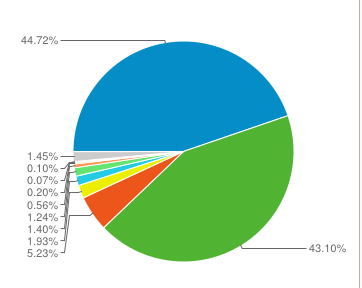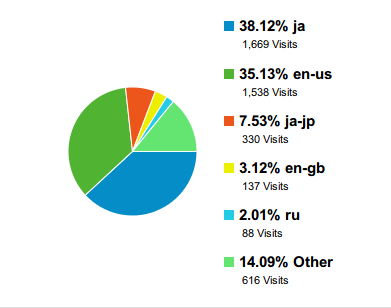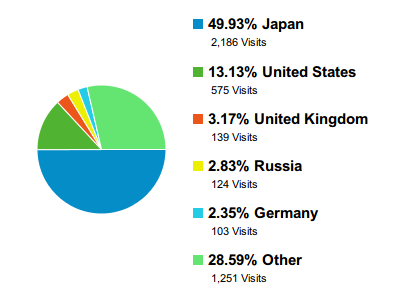I’m the kind of guy that likes to be open about data and such I thought it might be interesting to share what kind of access pattern my humble little bi-lingual blog gets. I really don’t get that many visits, so it’s not really useful to do any kind of deep analysis so, in terms of demographics, there are only a few metrics that are really useful to look at. Because this is a blog and because it’s bilingual the things I look at are what content people are looking at (particularly the language of the content), what the user’s language is, and where they are accessing from and that’s basically it:
- Content
- Language
- Location
Content
First, let’s talk about content. The content on my website is accessed about half and half. Really it’s about 44% English and 43% Japanese. The rest is a long tail of other URLs. But you can see that the content is accessed roughly equally.


I was really surprised how very close to equal the English and Japanese content accesses were. This also surprised me since I tend to update my Japanese content a lot more than my English content. I suppose this is a testament to the English speaking internet. My blog is ranked much higher in Japanese. All things being equal I should have a lot more accesses in Japanese but the English and Japanese accessed an equal amount.
Anyway, the really interesting part comes when we talk about language and content. Are Japanese speakers accessing the Japanese content? How about the English speakers? How are the users divided? These are questions I asked myself when looking at this kind of access data.
Language
Actually it’s not that interesting. As it turns out the languages are also split roughly 45% Japanese/40% English with the Japanese speakers reading the Japanese content and the English speakers reading the English content. Users in the long tail of languages, Russian, French, German etc. by and large read the English content. Those users make up the difference between the English and Japanese users in terms of access.

Location
I noticed another thing that was interesting when I looked at location data. Almost exactly 50% of the accesses come from inside Japan and only about 13% from the U.S. The rest is a huge long tail of countries from India, to Spain, to Kenya, to Latvia almost exclusively looking at English content.

Conclusion
I took a lot of this information into consideration when I redesigned my website. I focused more on blog content and displayed each language equally on the top page.
My life is in Japan, so the Japanese content is more pertinent to me and my career, but it’s clear, after looking at the data, that with half of the accesses being to English content, I should spend a bit more time on the English side of things.
